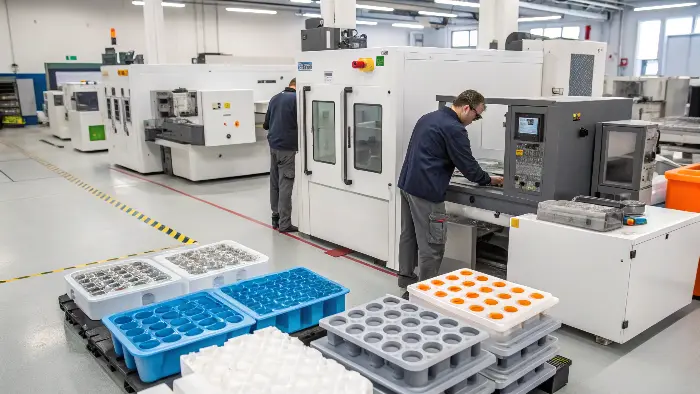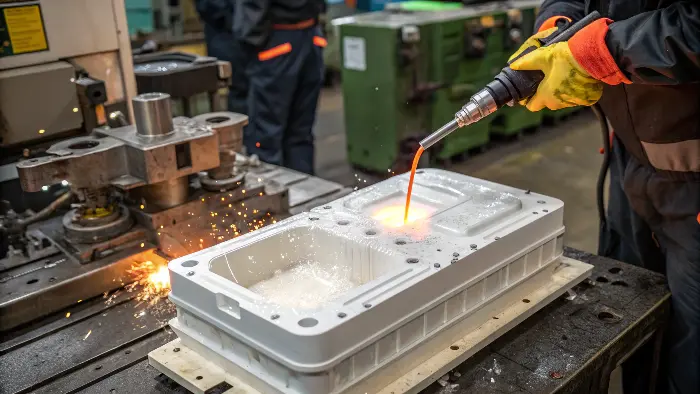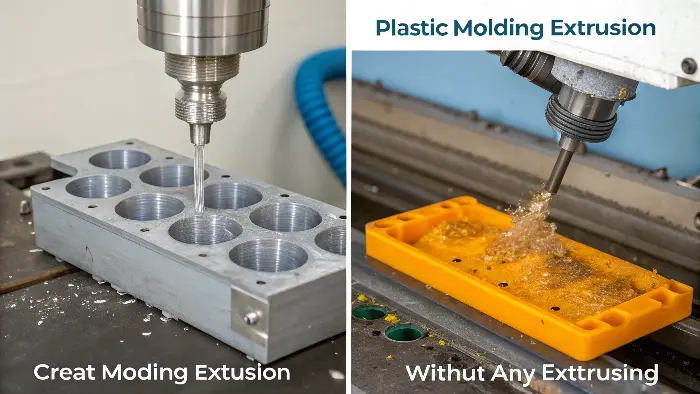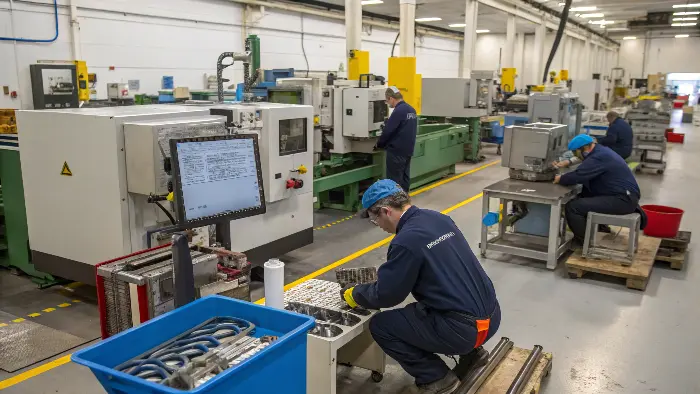Are you trying to make sense of the plastic manufacturing world? The term "plastic molding engineering" can sound complex and a bit mysterious. This confusion can be a real roadblock, preventing you from designing better products or understanding the production process. Let’s clear the fog and break down exactly what this critical engineering field is all about, so you can master your craft.
Plastic molding engineering is a specialized field that combines mechanical engineering, materials science, and manufacturing technology. It focuses on designing and creating molds, selecting the right plastic materials, and optimizing the process of shaping molten plastic into a final product. This discipline ensures that plastic parts are produced efficiently, meet precise specifications for quality and function, and are cost-effective for mass production. It’s the brain behind making everything from car parts to bottle caps.

That’s the high-level view. But to truly appreciate the "engineering" aspect, we need to start with the foundation. It all begins with the core manufacturing process itself. Once we have a solid grasp of what plastic molding is, understanding the science and precision behind it becomes much easier. So, let’s dive into the fundamentals first before we build up to the more complex engineering principles.
What is plastic molding?
You see plastic products everywhere, from your coffee maker to your car’s dashboard, but do you really know how they are made? The process can seem like a factory secret, a black box of industrial magic. Not understanding these basics can lead to design flaws that are expensive and frustrating to fix later. Let’s open that black box together and explain the core concept of plastic molding in simple terms.
Plastic molding is a manufacturing process for producing parts by injecting molten plastic material into a mold, or a rigid frame. The liquid plastic cools, solidifies, and takes the shape of the mold’s cavity. Once hardened, the part is ejected. This method is highly versatile and is used to create a vast range of items, from complex automotive components to simple household goods. It’s the go-to method for high-volume production of identical plastic parts.

To really understand this, let’s look deeper at the most common type, which is injection molding. I remember the first time I stood on a factory floor, watching a high-speed injection molding machine at work. It was like a perfectly timed dance of steel and plastic, repeating with incredible speed and precision. It’s a cyclical process, meaning it repeats the same steps over and over to produce thousands or even millions of identical parts.
The Injection Molding Cycle Step-by-Step
- Clamping: First, the two halves of the mold are securely closed by a powerful clamping unit. The force has to be immense to keep the mold shut against the pressure of the incoming molten plastic.
- Injection: Plastic pellets are melted in a barrel and then a screw pushes, or injects, the molten plastic into the mold’s cavity. The plastic fills every tiny detail of the mold.
- Dwelling (or Packing): After the cavity is filled, more pressure is applied to pack more material in. This step is crucial to compensate for plastic shrinkage as it cools and ensures the part is fully formed without voids.
- Cooling: The plastic inside the mold begins to cool and solidify, taking the shape of the cavity. This is often the longest part of the cycle and is critical for the final part’s stability and dimensions.
- Mold Opening: Once the part is cool enough, the clamping unit opens the two halves of the mold.
- Ejection: Ejector pins push the finished part out of the mold, and it falls into a collection bin. The cycle is now ready to begin again.
Common Types of Plastic Molding
While injection molding is the most famous, it’s not the only game in town. Different products require different methods. Here’s a quick look at some other common types:
| Molding Type | Process Description | Common Products |
|---|---|---|
| Injection Molding | Molten plastic is injected into a closed mold cavity under high pressure. | LEGO bricks, phone cases, car interior parts, bottle caps. |
| Blow Molding | A hollow tube of plastic (a parison) is inflated with air inside a mold, like blowing up a balloon. | Plastic bottles (soda, milk), hollow containers, fuel tanks. |
| Rotational Molding | Plastic powder is placed in a mold, which is then heated and rotated on two axes. The powder melts and coats the inside of the mold. | Large hollow items like kayaks, water tanks, playground slides. |
| Compression Molding | A pre-measured amount of plastic is placed in a heated mold, which is then closed, forcing the material to fill the cavity. | Electrical outlets, dinnerware, rubber seals. |
Understanding these basic processes is the first step. Now, let’s add the "engineering" layer to see how we turn this process into a precise science.
What is moulding engineering?
Knowing what molding is isn’t enough to guarantee success. Why do some plastic parts fail under stress while others last for decades? The secret isn’t just in the machine; it’s in the engineering. If you ignore the core engineering principles, you’re essentially just guessing, which can lead to weak parts, wasted material, and costly production delays. Your reputation as a designer or engineer is on the line with every part. Let’s explore the "engineering" part of the equation.
Moulding engineering is the discipline that applies scientific and mathematical principles to the entire molding process. It covers everything from part design for manufacturability (DFM) and mold design to material selection and process parameter optimization. The goal of a molding engineer is to ensure the final product is strong, dimensionally accurate, and produced efficiently with minimal defects. It’s the bridge between a product idea and a perfectly manufactured plastic part.

Moulding engineering is where the real magic happens. It’s a field that demands a deep understanding of physics, chemistry, and mechanics. I learned this the hard way early in my career. I worked on a project where the product designer created a beautiful-looking part, but they forgot to add a draft angle—a slight taper on the walls. When we tried to produce it, every single part got stuck in the mold. We wasted a full day and a lot of expensive material trying to fix it. A simple engineering check, a core part of moulding engineering, could have prevented the entire mess.
The Three Pillars of Moulding Engineering
This discipline really stands on three critical pillars:
- Part Design for Manufacturability (DFM): This is where it all starts. An engineer reviews the product design to make sure it can actually be molded effectively. This involves checking for things like uniform wall thickness to prevent sink marks, adding draft angles for easy ejection, and designing ribs and bosses correctly for strength without adding unnecessary material.
- Mold Design: The mold itself is not just a hollow block of steel; it’s a complex, high-precision machine. Engineers design the mold’s core and cavity, the intricate cooling channels that control temperature, the ejection system that pushes the part out, and the gate system that delivers the plastic. A well-designed mold can cost a lot, but it’s an investment that pays for itself through millions of perfect parts.
- Process Optimization: This is the science of fine-tuning the molding machine’s settings. Engineers experiment with injection pressure, melt temperature, cooling time, and dozens of other variables. They use data and analysis to find the perfect "recipe" that produces the strongest part in the shortest possible time, with the fewest defects.
Key Engineering Considerations
To be successful, a molding engineer must juggle several critical factors. Here are some of the most important ones:
| Consideration | Why It’s Important | Example |
|---|---|---|
| Material Selection | Different plastics have vastly different properties (strength, flexibility, heat resistance). Choosing the wrong one can lead to part failure. | Using flexible Polypropylene (PP) for a living hinge on a container lid, but using rigid Polycarbonate (PC) for a clear, impact-resistant face shield. |
| Shrinkage Calculation | All plastics shrink as they cool. The engineer must predict this shrinkage accurately and make the mold cavity slightly larger so the final part is the correct size. | If a plastic shrinks by 2%, a 100mm part needs a 102mm mold cavity. |
| Warpage Analysis | Uneven cooling can cause a part to warp or twist out of shape. Engineers use simulation software to predict and prevent this. | Designing cooling channels to cool thick and thin sections of a part at the same rate. |
| Cooling System Design | The cooling channels in the mold are like a radiator for the plastic. An efficient cooling design shortens the cycle time and improves part quality. | Placing more cooling lines around thicker sections of the part that hold more heat. |
What is the difference between plastic molding and extrusion?
In the world of plastics manufacturing, molding and extrusion are two of the biggest players. However, they are often confused with one another, and using the wrong term can make you sound inexperienced. Even worse, choosing the wrong process for your product can be a costly disaster, leaving you with a part that doesn’t have the right shape or properties. Let’s clear this up once and for all with a simple breakdown.
The main difference lies in how the plastic is shaped. In plastic molding (specifically injection molding), molten plastic is injected into a closed mold to create discrete, individual parts. In extrusion, molten plastic is continuously pushed through a die to create a long, continuous profile with a fixed cross-section, like a pipe or a window frame. Molding makes distinct objects, while extrusion makes long shapes.

To make this even clearer, let’s dive deeper into the comparison. The best way I’ve found to explain this to people is by using a simple analogy from the kitchen.
Process Analogy: Making Pasta
Think of it like making pasta at home.
- Injection Molding is like a ravioli press. You put your dough and filling into a mold, press it shut, and out comes a distinct, fully formed piece of ravioli. You repeat this process for each piece. It’s a cyclical process that creates individual items.
- Extrusion is like a classic pasta maker. You feed a lump of dough into the machine, and it continuously pushes it through a die with a specific shape. Out comes a long, continuous strand of spaghetti or fettuccine. You can then cut it to whatever length you need. It’s a continuous process that creates long profiles.
This simple analogy captures the fundamental difference: molding creates discrete 3D objects, while extrusion creates continuous 2D profiles that are extended in length.
Head-to-Head Comparison
Let’s break it down further with a direct comparison table. This is something every product designer, like Jacky, should have in their back pocket when starting a new project.
| Feature | Plastic Molding (Injection) | Plastic Extrusion |
|---|---|---|
| Process Type | Discontinuous (Cyclical). Makes one part (or set of parts) at a time. | Continuous. Produces a constant stream of material. |
| Part Shape | Creates complex, three-dimensional shapes with intricate details. | Creates linear, two-dimensional profiles with a fixed cross-section. |
| Tooling | Uses a complex and expensive two-part mold (core and cavity). | Uses a simpler and less expensive die. |
| Products | LEGO bricks, car dashboards, phone cases, gears, bottle caps. | Pipes, tubing, window frames, deck railings, weather stripping. |
| Dimensionality | The final part is defined in all three dimensions (X, Y, and Z) by the mold. | The final part has a defined 2D cross-section (X and Y) and a variable length (Z). |
| Cost | High initial tooling cost, but very low cost per part in high volumes. | Lower initial tooling cost, making it economical for shorter runs of profiles. |
Understanding this distinction is crucial for choosing the right manufacturing path for your product.
What is the job description of plastic molding?
Are you interested in a career in this field but feel unsure about what the day-to-day work actually looks like? Job titles like "Molding Technician" or "Process Engineer" can be vague. Without a clear understanding of these roles, you might pursue a path that doesn’t align with your skills or interests, leading to career dissatisfaction. Let’s pull back the curtain on the key jobs that make a plastic molding factory run.
A job in plastic molding typically involves operating, maintaining, or optimizing molding machinery and processes. Key roles include the Mold Technician, who sets up and troubleshoots machines; the Process Engineer, who develops and refines molding parameters to improve quality and efficiency; and the Mold Designer, who creates the detailed blueprints for the molds themselves. These roles require a blend of mechanical aptitude, problem-solving skills, and attention to detail to ensure consistent production of high-quality plastic parts.

When I first started working in a mold factory, I quickly realized it was a complete ecosystem. It wasn’t just one person pushing a button. It was a team of people with very different but interconnected roles, all working together to turn raw plastic pellets into finished goods. From the person running the machine to the engineer designing the mold in an office, every role is essential. For anyone looking to enter this industry, or for a designer like Jacky who works with it, understanding this ecosystem is key.
A Breakdown of Responsibilities
Let’s look at the most common roles you’ll find on the factory floor and in the engineering office. Each one plays a vital part in the production chain.
| Job Title | Primary Responsibilities | Key Skills |
|---|---|---|
| Machine Operator | Loads raw material, starts and monitors the molding machine, performs basic visual quality checks on parts, and packs finished goods. | Attention to detail, stamina, ability to follow procedures, consistency. |
| Mold Setter / Technician | Installs and removes molds from machines, sets up the initial machine parameters for a new job, performs first-part inspections, and handles basic troubleshooting. | Strong mechanical aptitude, problem-solving, safety-conscious, hands-on skills. |
| Process Engineer | Develops and optimizes the molding process to reduce cycle times, minimize defects, and improve part quality. Documents procedures and trains technicians. | Deep knowledge of plastics, analytical thinking, statistical process control (SPC), systematic problem-solving. |
| Mold Designer | Uses CAD software (like SolidWorks or AutoCAD) to design the mold. Responsible for DFM, cooling analysis, and creating the blueprints for the toolmakers. | High proficiency in CAD, creativity, deep understanding of molding principles, precision. |
| Quality Inspector / Engineer | Uses precision measurement tools (calipers, CMM) to ensure parts meet all dimensional specifications. Investigates quality issues and works with engineers to resolve them. | Precision, knowledge of GD&T (Geometric Dimensioning and Tolerancing), meticulousness. |
| Toolmaker | A highly skilled machinist who builds, maintains, and repairs the molds based on the mold designer’s blueprints. | Machining skills (CNC, EDM), precision metalworking, problem-solving. |
Each of these roles offers a unique career path within the vibrant and essential field of plastic molding.
Conclusion
In short, plastic molding engineering is a deep and rewarding field. It blends the hands-on process of shaping plastic with the rigorous science of engineering. By understanding the basic molding process, the engineering principles that ensure quality, its distinction from other methods like extrusion, and the various career paths available, you gain a complete and powerful perspective. It’s an industry full of challenges and opportunities for anyone willing to learn and innovate.
